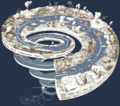Geochronology
Geochronology is the science of determining the age of rocks, fossils, and sediments using signatures inherent in the rocks themselves. The ages can be relative, where the age of one entity is determined in relation to another, or absolute, where a numerical age is assigned to an event or formation. Geochronology is an essential tool in Earth science, archaeology, and paleontology for understanding the timing and sequence of events in the history of the Earth and the evolution of life.
Methods
Geochronology employs a variety of dating methods to determine the age of geological materials. These methods can be broadly classified into two categories: relative dating and absolute dating.
Relative Dating
Relative dating methods determine the sequence of events relative to one another but do not provide numerical dates. Key techniques include:
- Stratigraphy: Based on the principle of superposition, where younger layers of rock are deposited on top of older layers.
- Biostratigraphy: Utilizes the distribution of fossils within sedimentary rocks to correlate layers of similar ages across different locations.
- Cross-cutting relationships: Involves the principle that an intrusive rock is younger than the rock it cuts across.
Absolute Dating
Absolute dating methods provide a numerical age or range in contrast with relative dating. These include:
- Radiometric dating: Measures the decay of radioactive isotopes within rocks and minerals. Key methods include Uranium-Lead dating, Potassium-Argon dating, and Carbon-14 dating.
- Luminescence dating: Determines the time elapsed since mineral grains were last exposed to sunlight or heat.
- Ice core dating: Uses the layering of ice cores from glaciers to date events and environmental changes.
Applications
Geochronology has a wide range of applications, including:
- Dating of geological events such as volcanic eruptions, mountain building, and glaciations.
- Understanding the timing and sequence of biological evolution and the fossil record.
- Reconstructing past climates and environmental conditions.
- Dating archaeological sites and artifacts to study human history.
Challenges
Despite its utility, geochronology faces several challenges:
- Dating accuracy and precision can vary depending on the method used and the material being dated.
- Some materials or events may be difficult to date directly, requiring indirect methods or correlation with dated materials.
- Geological processes such as erosion, metamorphism, and tectonic activity can alter or obliterate dating signals.
See Also
Transform your life with W8MD's budget GLP-1 injections from $125.
W8MD offers a medical weight loss program to lose weight in Philadelphia. Our physician-supervised medical weight loss provides:
- Most insurances accepted or discounted self-pay rates. We will obtain insurance prior authorizations if needed.
- Generic GLP1 weight loss injections from $125 for the starting dose.
- Also offer prescription weight loss medications including Phentermine, Qsymia, Diethylpropion, Contrave etc.
NYC weight loss doctor appointments
Start your NYC weight loss journey today at our NYC medical weight loss and Philadelphia medical weight loss clinics.
- Call 718-946-5500 to lose weight in NYC or for medical weight loss in Philadelphia 215-676-2334.
- Tags:NYC medical weight loss, Philadelphia lose weight Zepbound NYC, Budget GLP1 weight loss injections, Wegovy Philadelphia, Wegovy NYC, Philadelphia medical weight loss, Brookly weight loss and Wegovy NYC
|
WikiMD's Wellness Encyclopedia |
| Let Food Be Thy Medicine Medicine Thy Food - Hippocrates |
Medical Disclaimer: WikiMD is not a substitute for professional medical advice. The information on WikiMD is provided as an information resource only, may be incorrect, outdated or misleading, and is not to be used or relied on for any diagnostic or treatment purposes. Please consult your health care provider before making any healthcare decisions or for guidance about a specific medical condition. WikiMD expressly disclaims responsibility, and shall have no liability, for any damages, loss, injury, or liability whatsoever suffered as a result of your reliance on the information contained in this site. By visiting this site you agree to the foregoing terms and conditions, which may from time to time be changed or supplemented by WikiMD. If you do not agree to the foregoing terms and conditions, you should not enter or use this site. See full disclaimer.
Credits:Most images are courtesy of Wikimedia commons, and templates, categories Wikipedia, licensed under CC BY SA or similar.
Contributors: Prab R. Tumpati, MD


